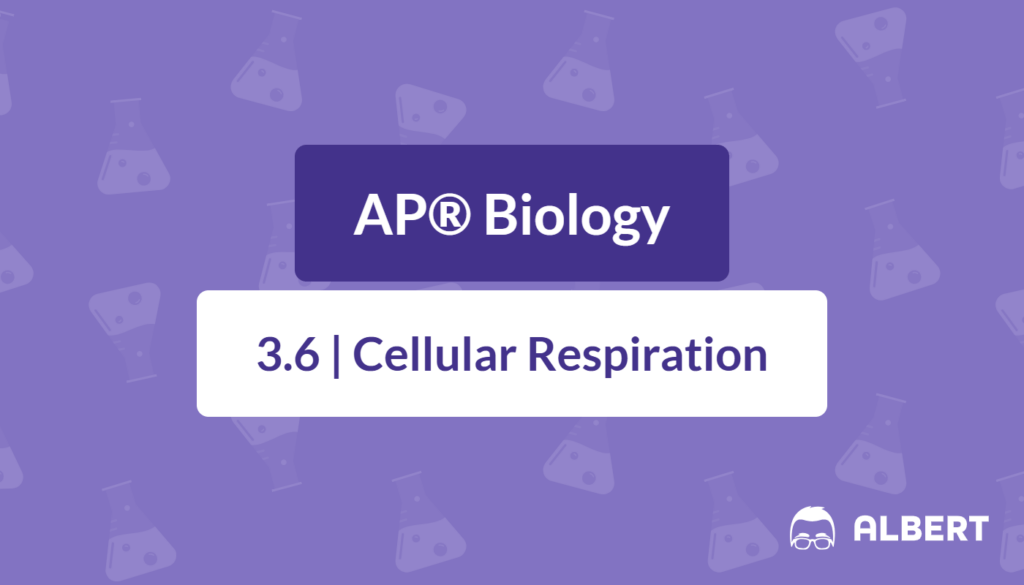What We Review
Introduction
Cellular respiration is a fundamental process that allows cells to produce energy by converting the chemical energy in biological macromolecules into adenosine triphosphate (\text{ATP}). In AP® Biology, understanding how cells derive and use energy is crucial. By mastering the cellular respiration equation and the associated steps, you’ll be well-prepared for exam questions and advanced topics.
What is Cellular Respiration?
Simply put, cellular respiration is the process by which cells break down glucose, a simple sugar, in the presence of oxygen to generate \text{ATP}—the energy currency of the cell. Think of this as a controlled series of chemical reactions that prevent the energy from being released all at once. Instead, it’s gradually harvested to power various metabolic processes essential for life.
The Cellular Respiration Equation
The balanced form of the cellular respiration equation is:
\text{C₆H₁₂O₆ + 6O₂ → 6CO₂ + 6H₂O + ATP}- Reactants of Cellular Respiration:–
- Glucose (\text{C₆H₁₂O₆})
- Oxygen (\text{O₂})
- Products of Cellular Respiration:
- Carbon dioxide (\text{CO₂})
- Water (\text{H₂O})
- \text{ATP} (chemical energy)
This formula represents the overall process; however, keep in mind that it unfolds through multiple steps and involves various enzymes.
Where Does Cellular Respiration Take Place?
Most of cellular respiration happens inside the cell’s mitochondria (often called the “powerhouse” of the cell). However, the process begins in the cytoplasm. Below is a quick location overview:
- In Eukaryotic Cells:
- Glycolysis occurs in the cytoplasm.
- The Krebs cycle (also known as the citric acid cycle) and the electron transport chain happen in the mitochondria.
- In Prokaryotic Cells:
- While prokaryotic cells don’t have membrane-bound organelles like mitochondria, they still perform cellular respiration. Glycolysis occurs in the cytoplasm, and parts of the respiratory processes occur across the cell’s plasma membrane.
Steps of Cellular Respiration
Below is a brief overview of the three main stages, highlighting what happens at each step. This knowledge often appears in AP® Biology exam questions, so pay close attention!

- Glycolysis
- Location: Cytoplasm.
- Reactants: One glucose molecule, two \text{ATP} molecules (to initiate the process), and \text{NAD⁺}.
- Products: Two pyruvate molecules, a net gain of two \text{ATP}, and \text{NADH}.
- Key Points: Glycolysis does not require oxygen and can provide energy quickly.
- Krebs Cycle (Citric Acid Cycle)
- Location: Mitochondrial matrix (in eukaryotic cells).
- Reactants: Acetyl-CoA (derived from pyruvate), \text{NAD⁺}, \text{FAD}.
- Products: \text{CO₂}, \text{NADH}, \text{FADH₂}, and some \text{ATP}.
- Key Points: This cycle produces critical electron carriers (\text{NADH}, \text{FADH₂}), which power the next stage.
- Electron Transport Chain (ETC)
- Location: Inner mitochondrial membrane (in eukaryotic cells).
- Process: High-energy electrons from \text{NADH} and \text{FADH₂} move through protein complexes, creating a proton gradient across the membrane.
- Role of Oxidative Phosphorylation: The flow of protons through the ATP synthase enzyme drives the conversion of \text{ADP} to \text{ATP}.
- End Products: Large amounts of \text{ATP} and water.
Products of Cellular Respiration
- \text{ATP}: The primary energy molecule cells use for metabolic processes.
- Carbon Dioxide (\text{CO₂}): A waste product exhaled by organisms that breathe.
- Water (\text{H₂O}): Generated during the final electron transfer steps.
These products are vital to various biological functions (e.g., \text{CO₂} is used by plants for photosynthesis, and water is essential for countless biochemical reactions).
Importance of Cellular Respiration
Cellular respiration is essential because it provides the \text{ATP} needed for activities ranging from muscle contraction to active transport across membranes. \text{ATP} essentially fuels most cell functions, making cellular respiration a cornerstone of life.
Fermentation: An Alternative Pathway
When oxygen is scarce (or absent), cells can switch to an anaerobic process called fermentation. Although it yields far less \text{ATP} than aerobic respiration, fermentation can still keep cells functioning under low-oxygen conditions.
- Alcoholic Fermentation: Occurs mainly in yeast and some bacteria; produces ethyl alcohol and \text{CO₂}.
- Lactic Acid Fermentation: Occurs in muscle cells and certain bacteria; produces lactate (lactic acid).
Practice Problems
Try these questions on your own first, then check with your textbook or class notes to solidify your understanding.
- Differentiate between the roles of \text{NADH} and \text{FADH₂} in aerobic respiration.
- Explain why glycolysis can continue in the absence of oxygen but the Krebs cycle cannot.
- Summarize the overall \text{ATP} yield from one glucose molecule undergoing cellular respiration.
- Compare and contrast alcoholic fermentation and lactic acid fermentation in terms of products and organisms where they commonly occur.
Conclusion
In summary, the cellular respiration equation—\text{C₆H₁₂O₆ + 6O₂ → 6CO₂ + 6H₂O + ATP}—encapsulates the essential process by which cells harness energy. Understanding where cellular respiration occurs, what the reactants are, and the products it generates is fundamental for mastering AP® Biology. A clear grasp of the steps and their interdependence ensures you’re equipped to tackle questions on this crucial topic.
By focusing on what cellular respiration is, where it takes place, and the significance of its products, you’ll build a strong conceptual foundation. This knowledge will be invaluable not only for the AP® Biology exam but also for any advanced studies in biology. Good luck!
Sharpen Your Skills for AP® Biology
Are you preparing for the AP® Biology test? We’ve got you covered! Try our review articles designed to help you confidently tackle real-world math problems. You’ll find everything you need to succeed, from quick tips to detailed strategies. Start exploring now!
Need help preparing for your AP® Biology exam?
Albert has hundreds of AP® Biology practice questions, free response, and full-length practice tests to try out.








